look what the cat’s dragged in: Idiom Meaning and Origin
What does ‘look what the cat's dragged in’ mean?
The idiom look what the cat's dragged in means to express surprise or displeasure upon seeing someone or something that is unexpected, unwelcome, or disheveled.

Idiom Explorer
The idiom "the cat's out of the bag" means that a secret or hidden information has been revealed or made known to everyone, often causing surprise or a negative outcome.
The idiom "see which way the cat jumps" means to wait and see how a situation develops before making a decision or taking action.
The idiom "out of nowhere" means something unexpectedly or suddenly appearing without any prior indication or warning.
The idiom "on the outside, looking in" means to be excluded or feel excluded from a group or activity, typically observing it from a distance and feeling a sense of isolation or being left out.
The idiom "on stun" means to be surprised or shocked by something. It is often used to emphasize the level of surprise or shock.
The idiom "one of those things" refers to a situation or event that is out of one's control, often unexpected or difficult to explain or understand.
The idiom "oh my" is an expression of surprise or shock, often used in a humorous or exaggerated way. It conveys a sense of astonishment or disbelief in response to something unexpected or extraordinary.
The idiom "of all things" is used to express surprise or disbelief about something unexpected or unlikely. It emphasizes the unexpectedness of the thing being referred to.
The idiom "not a pretty sight" means that something or someone is unattractive or unpleasant to look at.
The idiom "look up and down" means to examine someone or something carefully, often in a judgmental or critical manner.
Cat's Curious Catch
The idiom "look what the cat's dragged in" is a familiar phrase used in colloquial English. Its origins can be traced back to the mid-19th century, although the exact source remains uncertain. The phrase is often used informally to express surprise or disapproval upon encountering someone or something unexpected or unwanted.
The main feature of this idiom is its use of the metaphorical image of a cat bringing in something undesirable. Cats are known for their propensity to hunt and bring home small animals or objects, often as gifts to their owners. In this idiom, the cat's action of dragging in something implies an element of surprise and disregard for the worth or desirability of the object brought in.
The idiom "look what the cat's dragged in" is commonly used in informal conversations, and the context in which it is used can vary. It can be employed to express annoyance or displeasure upon encountering an unwelcome person who is considered undesirable or uninvited. The phrase can also be used humorously or playfully in situations where a person unexpectedly arrives or does something unusual.
It is worth noting that the idiom is often used in a slightly derogatory or mocking manner, suggesting that the person being referred to is of a lower social status or has done something disagreeable. However, the exact level of negativity conveyed can depend on the tone and context in which it is used.
Another related idiom is "dog my cats." This expression has a similar meaning to "look what the cat's dragged in." It is used to express surprise or shock upon encountering something unexpected. The use of "dog" in this idiom adds emphasis and intensifies the surprise, creating a more vivid and lively expression.
Similarly, the idiom "cat in the meal-tub" shares a common theme with "look what the cat's dragged in." It is used to describe a disruptive or unwanted presence in a situation or group. Just as the idiom "look what the cat's dragged in" refers to an unexpected arrival or appearance, "cat in the meal-tub" conveys the idea of an unwelcome intruder or disruption.
Lastly, there is the idiom "holy catfish." This phrase is used to express surprise or astonishment, much like "look what the cat's dragged in." The use of "holy" in this idiom adds a sense of exaggeration and emphasis to the surprise being expressed, creating a more dramatic effect.
Although the idiom is well-established and widely recognized, its usage may vary across different regions or social groups. It is particularly prevalent in informal speech and can be found in various forms, such as "look who the cat dragged in" or "look what the cat's brought in." The idiom's popularity can be attributed to its simplicity and vivid imagery, making it a memorable and easily understood expression.
While the idiom "look what the cat's dragged in" has become ingrained in everyday English, its origins and exact nuances remain somewhat elusive. The idiom's metaphorical use of a cat bringing in something unwanted adds depth and color to the language, capturing the element of surprise and disdain in encountering unexpected or undesirable people or things. As with many idioms, the true origins and evolution of this phrase may continue to remain a mystery, leaving room for speculation and interpretation.
Example usage
Examples of how the idiom "look what the cat's dragged in" can be used in a sentence:
When Jack arrived home after a long night out, his disheveled appearance and disoriented state made his mother exclaim, "Look what the cat's dragged in!"
As soon as Sarah stepped into the office wearing a wrinkled shirt and mismatched shoes, her colleagues couldn't help but tease her, saying, "Well, well, look what the cat's dragged in!"
When Sam's friend unexpectedly showed up at his house with muddy shoes and messy hair, Sam jokingly greeted him with, "Look what the cat's dragged in! Can't believe you went through a mud pit to get here."
More "Expression" idioms



